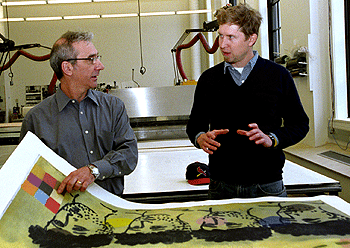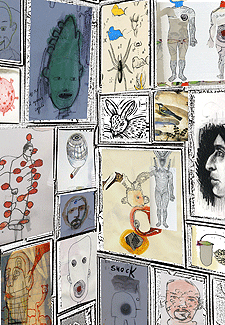Since arriving on campus last July, Carmon Colangelo, inaugural dean of the Sam Fox School of Design & Visual Arts, has been a busy man.
In August, the Sam Fox School — which combines distinguished programs in art and architecture with one of the nation’s finest university museums — formally began classes as a single academic and administrative unit.

In September, Colangelo debuted “Configured/Disfigured,” an exhibition of prints, at the Bruno David Gallery. That same month, he was installed as the E. Desmond Lee Professor for Community Collaboration in the Arts.
In October, the Sam Fox School hosted more than 1,300 visitors for the dedication of two new buildings — the Kemper Art Museum and the Earl E. and Myrtle E. Walker Hall — designed by Pritzker Prize-winning architect Fumihiko Maki.
In November, Colangelo welcomed Bruce Lindsey as the new dean of the College of Architecture and Graduate School of Architecture & Urban Design. And the following month, “Configured/Disfigured” traveled to Atlanta’s Sandler Hudson Gallery.
“Things have been a little hectic,” Colangelo says. “In a way we’re all still getting to know one another. But there’s been a real sense of energy and there’s a lot of common ground on which to build. Artists and architects can have very different ways of looking at things, but we use a lot of the same critical and analytic tools. The challenge is to become a unified school without losing those discipline-specific ideas or that sense of professional concentration.”
Colangelo has the personality and skills to succeed amid the changes and challenges, colleagues say.
“Carmon is a thoughtful, knowledgeable and hard-working administrator as well as an artist of substance,” says Jeff Pike, dean of the College of Art and the Graduate School of Art. “I have witnessed his sensitivity to the challenges of implementing the school’s new structure and his attention to the concerns of those who have been affected by the changes. He leads through relationship-building.”
Colangelo was born and raised in Toronto, the son of immigrants from the small mountain town of Monteleone di Puglia in southern Italy. His father, Pat, started out cutting hair at a local racetrack but eventually opened a small string of barbershops.
“My father saw himself as a businessman,” Colangelo recalls. “He always wore a suit and tie, though we used to joke the only thing in his briefcase was a salami sandwich. But he was very entrepreneurial, and my parents really believed in education. It was just a given — a fact — that I was going to college.”
As a young artist, Colangelo was deeply influenced by his parents’ love for the old country and copied works by Michelangelo, Da Vinci and Rubens, among others. “Of course, my friends wanted me to airbrush their vans,” Colangelo says.
After high school, he enrolled at the Ontario College of Art and Design, a local commuter school, but soon withdrew.
“A lot of students were older, with professional careers, and I realized I wasn’t mature enough for that environment,” he says.
So, to his father’s chagrin, Colangelo spent the next year working construction. “He thought I’d never go back to school, but I kind of regrouped and applied to the University of Windsor [in Ontario],” he says. “It had a great art department but wasn’t ‘uppity’ — just real serious, working-class art students.”
Colangelo intended to study graphic design “or something practical,” he says, but was surprised when a painting of his father won a regional show at the prestigious Art Gallery of Windsor. He also discovered lithography, a complex, labor-intensive process that involves drawing on stone typically with a grease pencil.
“I was fascinated by the alchemy,” he recalls. “I loved the nasty chemicals; the physicality of lifting, graining and inking stones; the repetitive rhythms of working a press. And as a printmaker, you could do things ‘serious’ painters couldn’t. You were allowed to be an illustrator or a satirist.”
In 1981, Colangelo began graduate studies for a master of fine arts at Louisiana State University. Waiting to register for classes, he struck up a conversation with a classmate, Susan Berry. “She helped navigate the registration lines, and within a few weeks, we were dating,” Colangelo says, laughing. “Our connection was pretty immediate.”
The couple graduated in 1983 and married the following year. Carmon worked at the Open Studio, an artist-run printshop in downtown Toronto, and also took roofing work while teaching part-time at the Art Gallery of Ontario. But within a few months, he returned to LSU as a sabbatical replacement for a former professor.
“It was a weird experience,” he says. “I was pretty shy, and some of my graduate students had been classmates. But once I started teaching, I realized how much knowledge I actually possessed and how great it felt to problem-solve and share that information.”
In 1984, Colangelo took a job as printmaking coordinator at West Virginia University in Morgantown. Two years later, he also became graduate coordinator for the Division of Art and was named chair in 1993. Perhaps the highlight of his tenure came in 1996 when he co-organized “Remote Sensing,” the 1996 Southern Graphic Council (SGC) Conference.
“We realized that technology was bringing us all closer together and theorized about a virtual world that would blur boundaries between disciplines and even nations,” Colangelo explains. Some 800 printmakers from eight countries participated, doubling all previous SGC records. “More importantly, we demonstrated the viability of a broad, inclusive approach to printmaking, one that had room for everything from sound art to robotics.”
Colangelo’s own work also continued to evolve. “I became more and more experimental,” he notes. “I started to think less about producing editions and more about open-ended concepts. How do you use the matrix to make unique images? How do you layer images to generate different combinations or create sequential pieces?”

In 1997, Colangelo became director of the Lamar Dodd School of Art at the University of Georgia. Under his leadership, he recruited more than two dozen full-time faculty and staff positions, increased graduate and teaching assistantships by 50 percent and completed pre-design for a new $41 million art facility. The school also renovated a 13th-century monastery in Cortona, Italy, for its study abroad program and hosted an international print and book arts symposium on new media and globalization.
All the while, Colangelo maintained an impressive exhibition schedule. In the past decade, his work has been featured in 20 solo shows and dozens of group exhibitions in Argentina, Canada, England, Italy, Korea, Mexico, Puerto Rico and across the United States.
Today, his work can be found in the National Museum of American Art in Washington, D.C.; the Whitney Museum of American Art in New York; and the Fogg Art Museum at Harvard University, among many others.
“Printmakers make good administrators because we know how to work together and we understand the concept of delayed gratification,” Colangelo says.
Of course, the reality is a bit more complicated. In his first few months at Washington University, Colangelo reorganized art and architecture support staff, formed a committee to rewrite the school’s governance document, took steps to streamline hiring and tenure procedures and lowered bureaucratic hurdles for students taking classes in both art and architecture.
“I think faculty are starting to feel more comfortable with one another,” Colangelo says. “We’re generating more collaborative classes, and there’s a lot of agreement about which areas need attention. Technology and new media need attention, issues of the environment and sustainability need attention.”
The Sam Fox School also is investigating a shared core curriculum for architecture and art, as well as potential initiatives in new media, landscape architecture and other areas. The school has committed to expanding its interdisciplinary master of fine arts program and is searching for a nationally recognized leader to direct the Graduate School of Art. Colangelo also plans to increase collaborative efforts with other University areas and to continue building the school’s successful international programs.
Meanwhile, Colangelo’s own work continues to combine traditional and innovative techniques. His recent diptych “Evolution” and “Devolution” employs translucent blue overprinting to suggest a television or computer screen. For “Gray’s Anatomy,” “Einstein’s Bunny” and “Silkwood’s Bones,” the artist photographed and digitally printed original drawings, then added layers of silkscreen and wax, the latter wiped with ink, as in an intaglio process.
“I began improvising about popular mythologies relating to genetic research, bioengineering and cloning,” Colangelo explains. “I intended them to be whimsical and non-confrontational, but they ended up a little bizarre and increasingly satirical.”
Indeed, he often describes his work as a “phantasmagoria.”
“Phantasmagoria refers to a kind of shadowy picture — one that encompasses many things and constantly changes our understanding or perception of reality,” Colangelo says. “It speaks to the transient and the ephemeral, the fragile nature of life. It links the human spirit with the collective psyche and the eternal soul.”